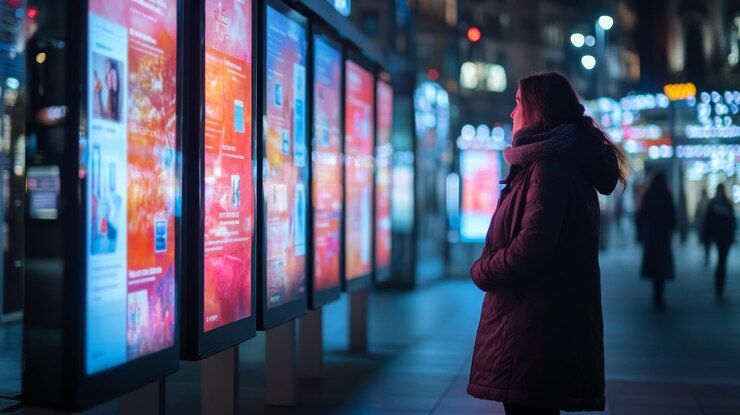Digital billboards are electronic display boards that use LED technology to present dynamic advertisements, messages, or public service content. Unlike traditional printed billboards, these allow content to be updated remotely and frequently, enabling advertisers to display multiple campaigns on a single screen.
They exist to meet the growing need for flexible, eye-catching advertising in high-traffic areas such as highways, malls, airports, and urban centers. As digital media consumption rises, advertisers seek formats that blend real-world presence with digital agility.

Why Digital Billboards Matter in Today's Advertising Landscape
Digital billboards have grown significantly in popularity due to several factors:
-
Visibility: Bright displays and motion attract more attention than static images.
-
Efficiency: Multiple ads can rotate on one board, maximizing screen time and revenue.
-
Real-time content: Brands can update messages instantly based on time, weather, or events.
-
Audience engagement: With motion graphics and animations, engagement rates tend to be higher.
-
Space utilization: One billboard can carry multiple advertisers, offering flexibility in urban planning.
This medium affects advertisers, urban developers, city planners, small businesses, and public authorities looking to communicate effectively in public spaces.
Recent Developments and Trends (2024–2025)
In the past year, the digital billboard industry has seen several innovations:
-
Programmatic Digital Out-of-Home (pDOOH): Automated, data-driven ad buying is expanding. Platforms like Vistar Media and Broadsign now allow marketers to schedule and serve ads based on time, weather, or demographics.
-
Eco-friendly LED panels: Manufacturers are shifting to energy-efficient LEDs with lower heat output.
-
3D Billboard Experiences: 3D anamorphic content—like those seen in New York’s Times Square or Tokyo’s Shibuya—are drawing global attention.
-
Integration with AI: Some billboards can now adjust messages based on real-time data inputs, including foot traffic or vehicle counts.
The global digital out-of-home (DOOH) market is forecasted to reach $35 billion by 2030, according to recent industry analysis.
Legal Framework and Government Regulations
The operation and placement of digital billboards are subject to government oversight to balance business needs with public safety and aesthetics. Key regulatory points include:
-
Zoning laws: Cities like New York, London, and Mumbai restrict digital billboard placement in residential or heritage zones.
-
Brightness and timing: Regulations often require limits on luminance levels and mandate dimming during nighttime.
-
Content compliance: Governments enforce restrictions on offensive content, tobacco, alcohol, and political advertising on public displays.
-
Traffic safety guidelines: Billboards near highways must not include flashing animations or quick transitions to avoid distracting drivers.
In India, the Municipal Corporation Act and the Outdoor Advertising Policy (2015) guide DOOH regulations, while in the U.S., the Federal Highway Administration (FHWA) sets standards under the Highway Beautification Act.
Helpful Tools and Platforms for Managing Digital Billboard Campaigns
Running or buying space on a digital billboard involves tools and resources for design, analytics, and automation:
Software & Platforms:
-
Broadsign – Programmatic DOOH ad buying and scheduling
-
Vistar Media – Real-time, data-driven ad placement
-
AdQuick – Compare locations and buy billboard space online
-
Scala – Digital signage content management system
-
Blip Billboards – Self-serve platform for small businesses
Design Tools:
-
Canva – Templates for digital billboard ads
-
Adobe After Effects – For creating 3D animations and transitions
-
Visme – For dynamic display-ready graphics
Analytics Tools:
-
Geopath – Provides measurement data for OOH ad impressions
-
Place Exchange – Offers insights into audience behavior in DOOH locations
Frequently Asked Questions
Q1. What’s the difference between digital and traditional billboards?
Traditional billboards are printed and static, while digital billboards use LED screens and can rotate several messages throughout the day.
Q2. Are digital billboards more expensive to advertise on?
They may have higher per-day costs, but they offer better visibility and flexibility. Many platforms offer short-term or budget-friendly time slots.
Q3. Can small businesses use digital billboards?
Yes. Self-serve platforms like Blip or AdQuick allow businesses to buy short ad bursts without long contracts.
Q4. Are digital billboards safe for drivers?
Yes, when placed and regulated properly. Most cities impose rules on brightness, animation speed, and content to ensure driver focus.
Q5. Do digital billboards work in all weather?
Most are built to withstand rain, heat, and cold, but extreme weather (e.g., snowstorms or floods) can affect operation temporarily.
Final Thoughts
Digital billboards combine the impact of traditional outdoor advertising with the agility of modern technology. As urban landscapes grow smarter, these displays serve both commercial and civic functions—offering advertisers visibility and cities a communication platform.
Whether you're an advertiser looking to reach a large audience or a policymaker balancing aesthetics and innovation, understanding how digital billboards function and evolve is essential in today’s media ecosystem.
